Pine Gap
| Pine Gap, which is heavily involved in a global american satellite spy system and in the Star Wars program, is located a less than 20 km from the city of Alice Springs, Australia. The installation has been there since the times of Kennedy. Orignally all started as a classified program, but right now average of population near the Pine Gap area know what's going on and have protested against americans' not-so-secret-anymore-base's presence, since it among other things "plays a big role in destabilising the peace and security of their nation and international relations and the potential for this facility to be used in the militarisation of space is of great concern".
| 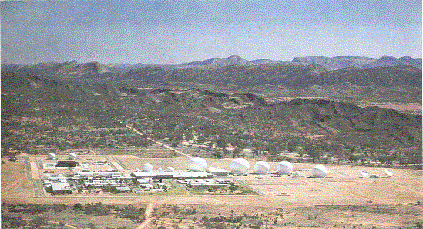 |

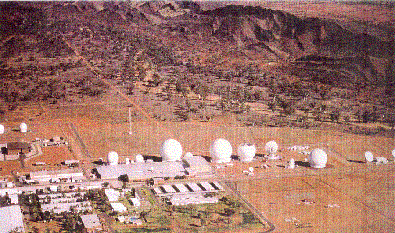
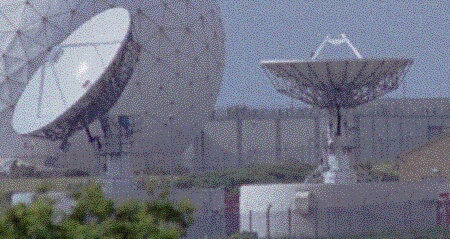 Sometime in the 60's United States government went to talk with the Australian Government about topic of constructing a "Satellite Relay Station" somewhere in the inland of Australia. United States Geological Survery investigated the area, and concluded central Australia to be selected as the region where to cnstruct the facility. Request was made to the Australian Government to provide suggested locations to construct the facility. They suggested a place as close as only 7 km from the town centre of Alice Springs but the place was found unsuitable by US Government, for a reason or another after it had been investigated. City's environs was found a good place for the future facility and on December 16, 1966 an announcement was made of a Joint Australian-American facility to be constructed near Alice Springs, Northern Territory of Australia.
Sometime in the 60's United States government went to talk with the Australian Government about topic of constructing a "Satellite Relay Station" somewhere in the inland of Australia. United States Geological Survery investigated the area, and concluded central Australia to be selected as the region where to cnstruct the facility. Request was made to the Australian Government to provide suggested locations to construct the facility. They suggested a place as close as only 7 km from the town centre of Alice Springs but the place was found unsuitable by US Government, for a reason or another after it had been investigated. City's environs was found a good place for the future facility and on December 16, 1966 an announcement was made of a Joint Australian-American facility to be constructed near Alice Springs, Northern Territory of Australia.
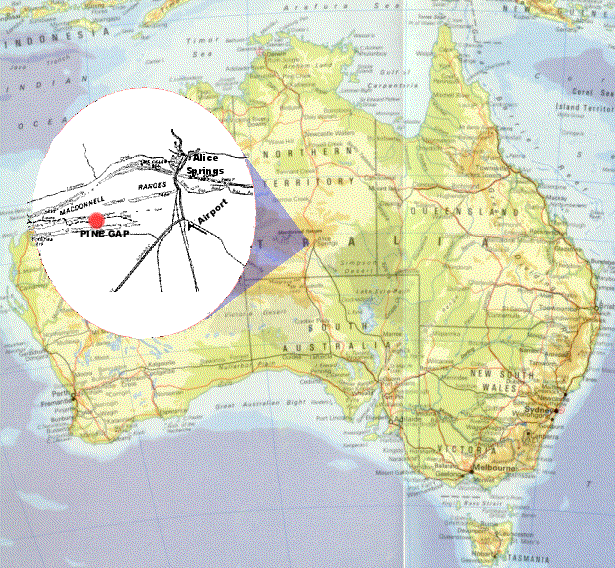
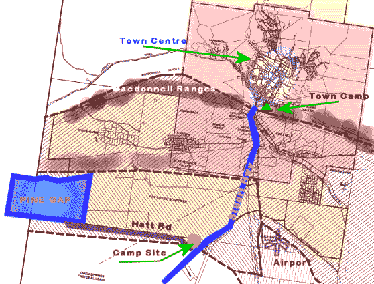 Very soon land owners observed American drilling teams wroking on their properties south west of Alice Springs. And right now it is said that under Pine Gap is the deepest drilling hole in Australia - about 5 miles ( more than 8000 metres ). Probably such a hole is used as an underground antenna able to recharge the batteries of submarines in the Pacific and Indian Ocean through ELF broadcasts. However, a sure fact is that such a gigantic antenna could be used to generate a gigantic stationary wave around the Earth. Project was to be completed over 18 months and land selected on Temple Bar Station was owned by mr. Jim Bullen.
Very soon land owners observed American drilling teams wroking on their properties south west of Alice Springs. And right now it is said that under Pine Gap is the deepest drilling hole in Australia - about 5 miles ( more than 8000 metres ). Probably such a hole is used as an underground antenna able to recharge the batteries of submarines in the Pacific and Indian Ocean through ELF broadcasts. However, a sure fact is that such a gigantic antenna could be used to generate a gigantic stationary wave around the Earth. Project was to be completed over 18 months and land selected on Temple Bar Station was owned by mr. Jim Bullen.
In next year's January Bullen was asked to volunteer his land to the project and offered 52 cents an acre for the land. Bullen owned 900 acres of land
( x $0.52=$470, not too fair ). Bullen asked for fair compensation and an assurance that the facility to be built is a wholly Australian operated facility and no military activity be performed at the proposed site. After this prime minister of Australia, Harold Holt, said there will be no launching or firing from the proposed Pine Gap facility. However Holt was then critisised by Alice Springs Member of the Northern Territory Government, Charlie ORR, for his "non-commital and misconstructed attitude" in relation to the information releases from the Americans. But also ORR questioned what economic benefit there would be for Alice Springs to have this base established.
In March mr. Richard Stallings gave a talk to members of the Alice Springs Rotary Club and was named as Senior US-Australian Representative of the facility. He announced that there would be "no serving military officers or men at the site" and that constuction of the buildings would be completed in 15 months and it would take a further 9 months to install the equipment. 25 Americans and about 60 Australians would be employed in the facility and initially with further advancement a further 100 Australians would be employed. Stalling also stated that the facility would expand over the years with most of the materials for the facility being prefabricated in the United States.
In April Mr. Charlie ORR voiced his concerns of the proposed facility. He listed his concerns as fears that the cost of living and property rentals may increase due to the 'military base'; concerns of the Americanisation of Alice Springs,; concerns over greater demand for local schools in regard to overcrowding,; and his concerns that the establishment of the facility was undemocratic since area's residents were not consulted.
May 1967 - Austalian commonwealth Gazette reports that Mr. Edwin J. Hatt of the Australian Department of Supply is to be based as Officer in Charge of Security at the Defence Facility. His job title referred to as Executive Officer and Representative of the Department of Defence.Formerly Mr. Hatt was in charge of security at teh Woomera Rocket Testing Range in South Australia. In the same year's June construction of the installation is halted when a general strike is called by the construction workers when their Trade Union calimed that workers were underpaid. Reg Harris, a prominent Alice Springs resident then speaks out in support of the defence facility. He stated that he discovered that the facility was inject a lot of finance and economic benefit to the town. He discovered 13 local companies were contracted to supply goods, services and labor valued at over $250,000. A survey of 300 Alice Springs residents revealed an "overwhelming support for the facility". Construction had slowed down due to extensive flooding as a result of torential rains. Proposed completion date was expanded. Now completion time was speculated to take a further 28 months to two years. Next month the general consturction supervisor, Mr. Noel Gee discloses what was supposed to be a secret revealing that there is extensive drilling taking place at the facility. Mr. Gee then rebutted his own comment saying that his workers had drilled two water bores and that the Facility would be self sufficient. Further he announced that the facility would have an unspecified number of buildings constructed mainly of concrete block work with little timber used. The facility under construction is open to the media for one day.
In 1970 Pine Gap finally becomes operational. This is the same year that the the first Rhyolite satellite was launched. And only after 4 years...:
1974 - The Australian Government announces that Pine Gap is being controlled by the CIA. Unauthorized photographs and other information from inside the facility are reported to have been sold to Russia. This, among other things that citizens of Australia are concerned about leads to many protests and then arrestings of many people who have done nothing wrong.
1985 - An unconfirmed report of an unidentified aircraft travelling at errastic speeds buzzes a government employee and police officers, just 100 km west of Alice Springs. Next year 300 people are arrested at a Pine Gap Protest Rally at the gates of Pine Gap.
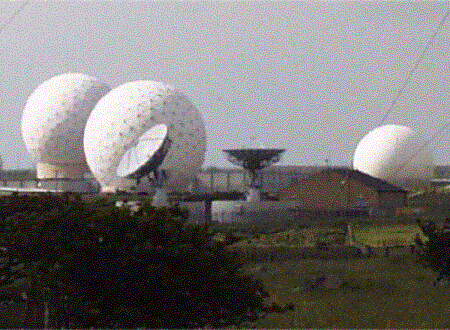
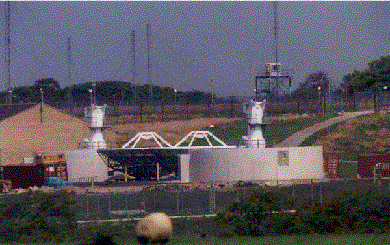
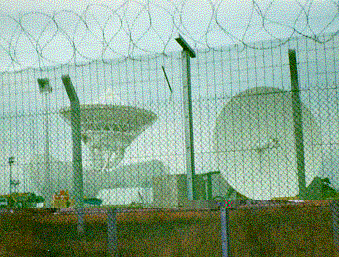
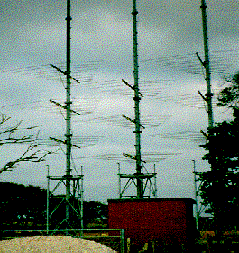
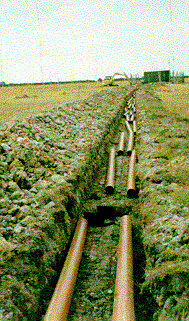 One of the determining factors of Pine Gap�s location was its remoteness. Firstly, being in an 'electronically quiet' area cuts down white noise and other electronic interference which would hamper the collection of relatively weak signals coming from satellites orbiting at about 36 000 kilometres. Pine Gap�s distance from coastlines or national borders makes it harder for download signals to be intercepted from spy ships and limits the electronic spill to a controllable area (in this case within the rugged terrain of central Australia).
The most striking feature of Pine Gap are the giant white geodesic "golfballs", known as radomes. These balls cover satellite dishes which communicate with the SIGINT satellites and provide protection both from the elements and from prying eyes which can determine the target satellites of each dish by their angle and direction.
One of the determining factors of Pine Gap�s location was its remoteness. Firstly, being in an 'electronically quiet' area cuts down white noise and other electronic interference which would hamper the collection of relatively weak signals coming from satellites orbiting at about 36 000 kilometres. Pine Gap�s distance from coastlines or national borders makes it harder for download signals to be intercepted from spy ships and limits the electronic spill to a controllable area (in this case within the rugged terrain of central Australia).
The most striking feature of Pine Gap are the giant white geodesic "golfballs", known as radomes. These balls cover satellite dishes which communicate with the SIGINT satellites and provide protection both from the elements and from prying eyes which can determine the target satellites of each dish by their angle and direction.
Along with the radomes, Pine Gap houses a large computer room. Rumoured to be amongst the largest in the world, computer operators communicate with each other via headsets across the almost 6 000 M2 of floorspace.
The satellites controlled from Pine Gap are known colloquially in the spy industry as Rhyolites, although this was the codename of the first generation of satellites, which have been superseded by Vortex, Acquacade, Chalet and Magnum.
SIGINT satellites are concerned with a range of different signals:
Telemetry Intelligence (TELINT) is the means by which militaries receive back information on how their missiles
are working. This is usually through Very High Frequency (VHF) and microwave bandwidths. This is the primary
source of information on other nations' Ballistic Missile programs.
Radar Intelligence (RADINT) monitors radar emissions, enabling the US to intercept a country�s radar network
providing it with information not just of its BM launches but all its radar information including military and
commercial aircraft movements.
Communications Intelligence (COMINT) refers to the ability to intercept telephone and microwave communications.
Most telephone, fax and email is transmitted across land by microwave links and it is this capability which
enables Pine Gap to intercept personal and commercial information which may have nothing to do with BMs or even
the military capabilities of the target nation. COMINT also monitors VHF radio communications as used in the
field by militaries and paramilitaries as well as most essential services.
SIGINT satellites are also able to intercept and retransmit data to, from and between other satellites, whether military or commercial. This is another means by which Pine Gap has access to private and commercial communications.
Another sinister role of Pine Gap is its use as a station in the Echelon spy network. Though the Echelon system is primarily run from the Australian Defence Signals Directorate's (DSD) Kojarena ground station near Geraldton in Western Australia, Pine Gap, as the major US facility in Australia also plays a prominent role; quite possibly as a relay station due to its secure communication links via fibre-optic cable all the way to CIA HQ at Langley, Virginia. Pine Gap also sends 'hard copy' of downloaded data through weekly USAF Starlifter visits to Alice Springs Airport. Pine Gap's capability in directing the movement of geostationary satellites and its interception capabilities through COMINT would also be being used by the Echelon network.
Recent revelations that the Echelon network was used to spy on communications between the Maritime Union of Australia and Capt Arne Rinnan of the Norwegian MV Tampa (while it was being held by the Australian military just outside Australian territorial waters after attempting to land with 438 asylum seekers the Tampa had rescued from a sinking ferry in international waters) show just how invasive the system can be. It is claimed that intercepted information was used by the Howard Government to determine on the fly policy in the lead up to a Federal election at the time.
There is no reason to believe that this was an isolated incident. The question out there is how many other communications between organisations working for social justice have been intercepted and used by US government to thwart their efforts?
Yet another aspect of Pine Gap is its place in the Missile Defense or 'Star Wars' plans of the US military. As the US Space Command's (USSC) own pictures show, Pine Gap is one of the three main sites for the Space Based Infrared Satellites (SBIRS) which form the backbone of the system.
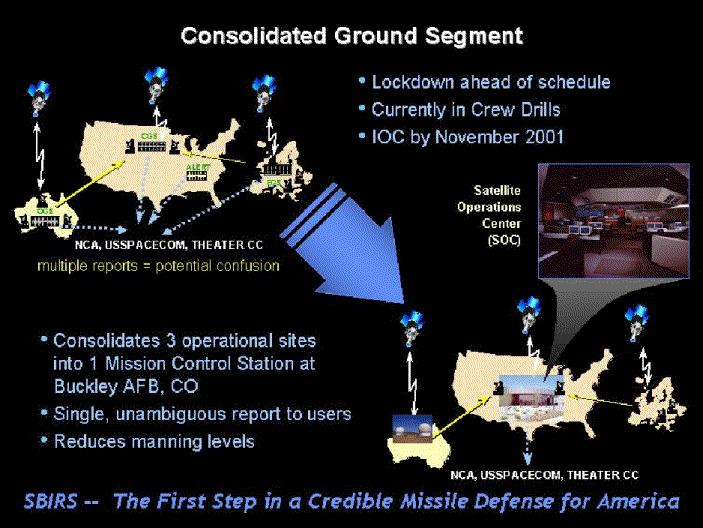
As G.W. Bush leads the world into a state of unending war, the uses to which Pine Gap will be put become even more alarming than ever. Pine Gap has been used in devastation wreaked on Afghanistan in response to the attacks on the World Trade Centre and probably again in Iraq, where conservative estimates of up to one million people have already been killed by the on-going economic blockade (now run by Australia) and the thousands of pounds of radioactive ammunition used over the last eleven years.
The 9 March 2002 revelation in the Los Angeles Times that the Pentagon has drawn up a 'Nuclear Posture Review' which outlines the possibility of for nuclear weapons being used against seven nations (Russia, China, North Korea, Iraq, Iran, Syria and Libya) as well as in the Middle East conflict leads to the conclusion that Pine Gap will be used in a nuclear war. As Bill Hayden, in his time as Foreign Affairs Minister in the Hawke Government stated: To prepare to fight a limited nuclear war... is to make a nuclear war more thinkable and therefore more possible".
